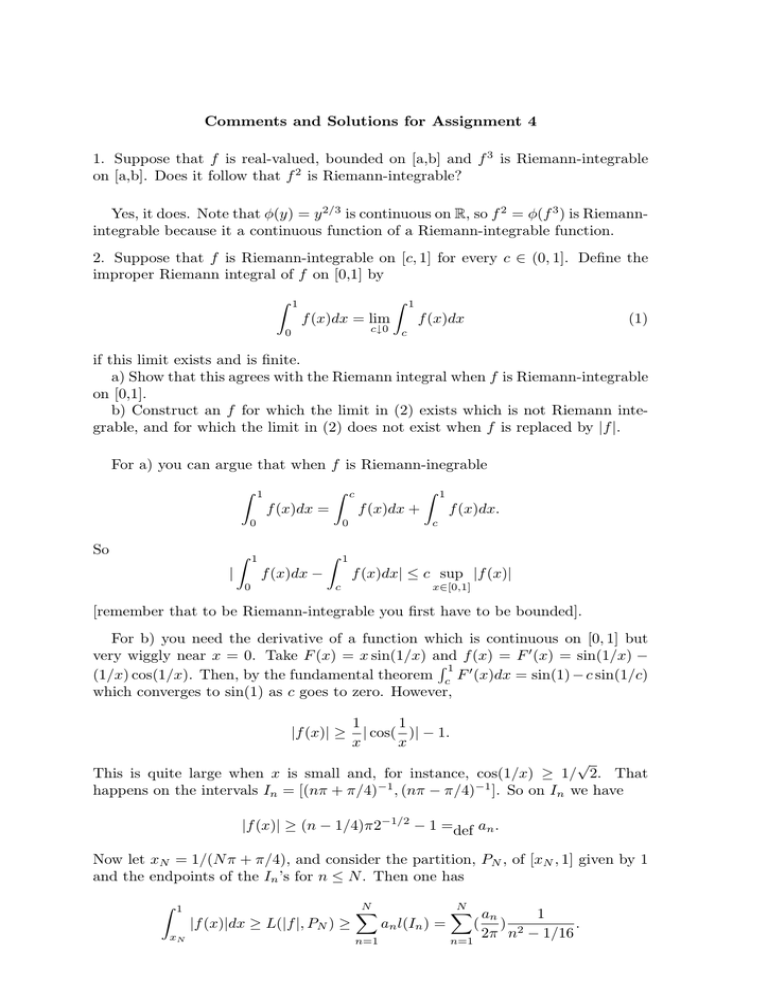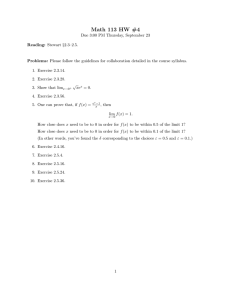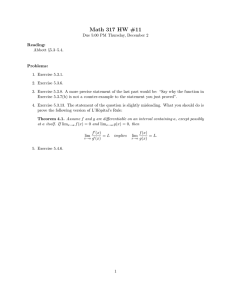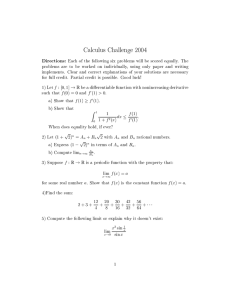Comments and Solutions for Assignment 4 1. Suppose that f is real
advertisement

Comments and Solutions for Assignment 4
1. Suppose that f is real-valued, bounded on [a,b] and f 3 is Riemann-integrable
on [a,b]. Does it follow that f 2 is Riemann-integrable?
Yes, it does. Note that φ(y) = y 2/3 is continuous on R, so f 2 = φ(f 3 ) is Riemannintegrable because it a continuous function of a Riemann-integrable function.
2. Suppose that f is Riemann-integrable on [c, 1] for every c ∈ (0, 1]. Define the
improper Riemann integral of f on [0,1] by
Z
Z
1
1
f (x)dx = lim
c↓0
0
f (x)dx
(1)
c
if this limit exists and is finite.
a) Show that this agrees with the Riemann integral when f is Riemann-integrable
on [0,1].
b) Construct an f for which the limit in (2) exists which is not Riemann integrable, and for which the limit in (2) does not exist when f is replaced by |f |.
For a) you can argue that when f is Riemann-inegrable
Z
Z
1
f (x)dx =
Z
0
Z
1
|
f (x)dx.
c
1
f (x)dx −
0
1
f (x)dx +
0
So
Z
c
f (x)dx| ≤ c sup |f (x)|
x∈[0,1]
c
[remember that to be Riemann-integrable you first have to be bounded].
For b) you need the derivative of a function which is continuous on [0, 1] but
very wiggly near x = 0. Take F (x) = x sin(1/x) and f (x) = F 0 (x) = sin(1/x) −
R1
(1/x) cos(1/x). Then, by the fundamental theorem c F 0 (x)dx = sin(1) − c sin(1/c)
which converges to sin(1) as c goes to zero. However,
|f (x)| ≥
1
1
| cos( )| − 1.
x
x
√
This is quite large when x is small and, for instance, cos(1/x) ≥ 1/ 2. That
happens on the intervals In = [(nπ + π/4)−1 , (nπ − π/4)−1 ]. So on In we have
|f (x)| ≥ (n − 1/4)π2−1/2 − 1 =def an .
Now let xN = 1/(N π + π/4), and consider the partition, PN , of [xN , 1] given by 1
and the endpoints of the In ’s for n ≤ N . Then one has
Z
1
xN
N
X
N
X
an
1
|f (x)|dx ≥ L(|f |, PN ) ≥
an l(In ) =
( ) 2
.
2π
n
−
1/16
n=1
n=1
2
However, the final sum above diverges by by limit comparison with
Z
lim
|f (x)|dx = ∞.
N →∞
P
n−1 , and
xN
3. (# 4 on Basic F’07, also in a more obscure version # 3 W’06) Suppose that
f : R → R is twice differentiable and |f 00 (x)| ≤ B for all x.
a) Prove that
Z A
f (x)dx| ≤ 2BA3 /3
|2Af (0) −
−A
b) Use the result of part a) to justify the estimate
Z
b
|
a
n
b−a X
2k − 1
C
(b − a))| ≤ 2
f (x)dx −
f (a +
n
2n
n
k=1
where C does not depend on n.
For a): The Taylor series expansion of f about x=0 gives
f (x) = f (0) + f 0 (0)x +
for some x∗ between x and 0. So
Z A
Z
|
f (x)dx − 2Af (0)| ≤ B
−A
x2 00 ∗
f (x )
2
A
x2 dx = B
−A
For b): Just apply a) with x = 0 replaced by x = a +
(b − a)/(2n). Then the estimate from a) becomes
Z
k(b−a)/n
|
f (x)dx −
(k−1)(b−a)/n
2A3
.
3
2k−1
2n (b
− a)) and A =
(b − a)
2k − 1
(b − a)3
f (a +
(b − a))| ≤ B
.
n
2n
3n3
Adding those up as k goes from 1 to n gives the result with C = B(b − a)3 /3.
4. Suppose that f on [0,1] is defined by
½
f (x) =
0,
if x is irrational
1/m, if x=n/m is lowest terms.
Show that f is Riemann-integrable on [0,1] and its integral is 0.
Recall that this function is continuous at all irrational numbers, and hence has
only countably many discontinuities – so it has to be Riemann-integrable. To
prove that without appealing to the general characterization of Riemann-integrable
functions you can argue as follows. Given ² > 0, let r1 , ..., rN be the rational
numbers in [0, 1] with denominators less that 2²−1 Take a partition containing the
points ri ± δ where δ > 0 is small enough that the intervals [rj − δ, rj + δ], j =
3
1, .., N are disjoint and 2N δ < ²/2. Consider the upper sum U (f, P ) for this
partition. Since 0 ≤ f (x) ≤ 1, the total contribution to U (f, P ) from the intervals
[rj − δ, rj + δ], j = 1, .., N is bounded by (2δ)N < ²/2, and, the contribution from
intervals not containing rj ’s is at most ²/2, since f (x) < ²/2 on those intervals. So
U (f, P ) < ². Since L(f, P ) ≥ 0, we have
Z
Z
1
0 ≤ L(f, P ) ≤
1
f (x)dx ≤
0
f (x)dx ≤ U (f, P ) < ²
o
which, since ² is arbitrary, implies that f is Riemann-integrable with integral 0.
5. Build a sequence of closed subintervals of [0, 1] as follows: set I1 = [0, 1],
I2 = [0, 1/2], I3 = [1/2, 1], I4 = [0, 1/4], I5 = [1/4, 1/2], and so on, filling out
[0,1] over and over, and halving the length of the intervals each time you start over.
R1
Let fn (x) = 1 on In and 0 elsewhere. Show that limn→∞ 0 fn (x)dx = 0 even
though limn→∞ fn (x) fails to exist for any x ∈ [0, 1].
This is a useful example, but it’s a trivial problem. Note 0 ≤ fn (x) ≤ 1 for
x ∈ [0, 1] and fn (x) = 0 outside an interval whose length goes to zero as n → ∞.
R1
So limn→∞ 0 fn (x)dx = 0. On the other hand, for each x, fn (x) = 1 for infinitely
many n and fn (x) = 0 for infinitely many n.
6. (Rudin) Letting {x} denote the fractional
P∞ part of 2x, i.e. {x} is the largest integer
less than or equal x, consider f (x) = n=1 {nx}/n . Find the discontinuities of f
and show that they form a countable dense set in R. Show that nevertheless f is
Riemann-integrable on every bounded interval in R.
The function gn (x) = {nx}/n2 is continuous except at the points x = k/n, k ∈ Z
(Z stands for the integers). Moreover at each of those points it “jumps down”,
i.e. limx↑k/n gn (x) = limx↓k/n gn (x) + 1/n2 . So, when you sum up the gn ’s, the
jumps do not cancel each other out. One should probably be a little more rigorous
here. The main observation
is that the sum defining f (x) converges uniformly:
P∞
|SN (x) − SM (x)| ≤ n=M +1 1/n2 for x ∈ R, where SN is the usual partial sum.
Since SN (x) converges uniformly to f (x),
lim f (x) = lim lim SN (x) and lim f (x) = lim lim SN (x),
x↓x0
N →∞ x↓x0
x↑x0
N →∞ x↑x0
provided that limx↓x0 SN (x) and limx↑x0 SN (x) exist for each N . This shows that
f (x) is continuous at the irrationals, since the gn ’s are, and discontinuous at the
rationals.
PN
However, on any bounded interval one sees that SN (x) = n=1 gn (x) is a function with only finitely many points of discontinuity for each N , and therefore is
Riemann integrable. Thus the sequence of Riemann-integrable functions {SN (x)}
converges uniformly to f (x), and we conclude that f is Riemann-integrable.






